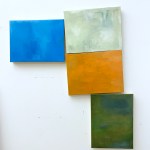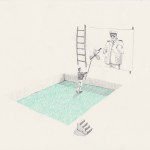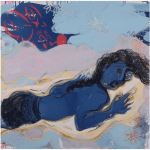Francis Bacon is one of those painters every beginning painting student adores because Bacon�s work is so much more accessible than the abstract painters who were exploring similar existential themes during the same period. The accessibility of Bacon�s corporeal vision is undoubtedly why his work appeals so strongly to new collectors short on art theory. Not surprisingly, during today�s opening remarks at the press preview for the Bacon exhibition that opens this week at the Met, curator Gary Tinterow cited Bacon�s influence on later artists (primarily Damien Hirst and the YBAs) as one of the primary reasons that this show is so important. The second reason, Tinterow declared, is the fact that Bacon is dead.
Huh? Well, it seems that many of Bacon�s friends and colleagues who were reluctant to dish while the painter was alive, have come forward to give us a more fully formed picture of Bacon�s life and working process than was available during the last Bacon retrospective twenty years ago. Additionally, after Bacon died, the source material in his notoriously cluttered London studio was sorted and catalogued, and 65 pieces from the archive are included in the exhibition. The dog-eared magazine images, crumpled photographs, and torn book pages, many painted over or altered by the artist, are my favorite part of the show. Bacon�s sketches and notes reveal that he was, to use Jung�s categories, a thinker who struggled to reconcile his need to explain and tell with his desire to make the viewer feel.
The exhibition, arranged chronologically, shows a self-taught artist earnestly learning how to paint in the early years. According to Tinterow, one of the reasons that Bacon framed his paintings under glass was so that the reflections and sheen would camouflage his technical shortcomings. The later work shows a mastery of materials and a much richer understanding of color, but the early immediacy and agitation have been replaced by a more placid, decorative approach, not unlike DeKooning�s path from edgy action painter to lyrical abstractionist.
Bacon’s paintings aren’t all that influential among young artists today, but perhaps, thanks to this show, we can look forward to some screaming, yelping angst emerging from grad school studios in the near future, instead of the text-heavy theoretical constructs we�ve become accustomed to.
The exhibition is accompanied by a fully illustrated catalogue published by Tate Publishing, with essays by Martin Harrison, David Mellor, Simon Ofield, Rachel Tant, Gary Tinterow, and Victoria Walsh.

Charming and articulate, curator Gary Tinterow leads the press tour through the exhibition.

Tinterow, giving one of many interviews surrounded by a gallery of Bacon’s brighter paintings. (The Met’s press kit for the Bacon show, a work of art itself, is entirely digital, which is very much appreciated.)

“Men Wrestling,” lower half of a plate from Eadweard Muybridge’s The Human Figure in Motion (Philadelphia, 1887; New York: Dover, 1955) 10 3/4 x 7 13/16 in. (27.3 x 19.9 cm). Dublin City Gallery The Hugh Lane

George Dyer in the Reece Mews Studio,ca. 1964. Gelatin silver print, torn and ripped, with scotch tape and paint additions. 11 15/16 x 11 15/16 in. (30.3 x 30.3 cm) unframed. Dublin City Gallery The Hugh Lane.

Photo-booth portraits of Francis Bacon, George Dyer, and David Plante in Aix-en-Provence, mounted to the inside cover of a book 1966�1967. 10 3/16 x 8 11/16 in. (25.9 x 22 cm) The Estate of Francis Bacon, courtesy Faggionato Fine Arts, London, and Tony Shafrazi Gallery, New York
“Francis Bacon: A Centenary Retrospective,” curated by Gary Tinterow, Matthew Gale, and Chris Stephens. Organized by Gary Tinterow, Anne L. Strauss, and Ian Alteveer. The Metropolitan Museum, New York, NY. May 20 �August 16. Exhibited at Tate Britain and the Museo Nacional del Prado, Madrid before its presentation at the Metropolitan Museum.
Related post:
A roundup of reviews written when the show was at the Tate: “Francis Bacon was one of the greatest painters of the twentieth century…”
















�The accessibility of Bacon�s corporeal vision is undoubtedly why his work appeals so strongly to new collectors short on art theory�.And what of earlier collectors? Alfred H Barr, for example, purchased Painting 1946 in 1948 for MoMA, a powerful endorsement for an artist as yet not 40, in a time when the art market was struggling in a depressed economy. And Barr was hardly an untutored eye. But the stampede has been on, pretty much ever since.
It seems condescending to say that new collectors are short on art theory in falling in with a late 20th Century favorite. There are books and books on Bacon, for those wanting theory. His influence is mainly through the British Pop artists, like Kitaj and Hockney who adopt the photo-based imagery with a little more detachment, and in America in the early work of people like Irving Petlin. Hirst�s ardent support is also a fairly transparent bid for his own historical position. It�s the old, �he�s great because he influenced me� line, we get from the ambitious artist with an eye to art history.
Bacon�s popularity is less in his intimations of sadism and homosexuality than in what he can do with the figure after Picasso, Cubism and Expressionism. This is what all the excitement was about in the 50s. Where does figuration go for standards by the middle of the century? How much or what of tradition is preserved? To understand what Bacon does, why he�s so original one must look where he starts from � with Picasso (via Roy de Maistre) and Surrealism, sanctioned by establishment figures like Herbert Read and Roland Penrose. Barr doesn�t just blindly stumble upon him in post-war London.
True, Bacon was somewhat primitive or na�ve in technique, but luckily this is what enables him to skip the kind of drawing Picasso or Klee and followers are committed to, the kind of perspectival and proportional sophistication that enthralled Dali or Ernst. He�s not alone in looking for ways around these things � Giacometti is both a model and a rival, and for a time Sutherland is a colleague. Not for nothing was de Kooning intrigued by his work � NY artists were having the same problem in finding a basis for abstraction. Although there the influence runs through Mir? via Gorky rather than Dali or Ernst.
But what Bacon is prepared to do is treat photography in common print sources (especially scientific or documentary sources) as valid models for painting. This is hard to understand, or perhaps to see, and there is probably an existential tinge to the attitude that these sources are never exactly accurate, that they cannot really picture the things their captions purport. Although this kind of skepticism seems to belong to the era rather than the artist�s reading.
But gradually, Bacon, by his own admission, does learn to draw, and interestingly the later work takes on a strong curvilinear style, that often recalls the biomorphic shapes of early Mir? or Arp. One never entirely escapes one�s time. But if Bacon remains a firm favorite with collectors and public it�s probably because there remains so much more to the work than a preview of Pop Art or a postmodern love of artifice and eclecticism. The power of the influence is ultimately in its diffuseness.